Simulation of Spatiotemporal Land Use Changes for Integrated Model of Socioeconomic and Ecological Processes in China
Abstract
1. Introduction
2. Materials and Methods
2.1. The Global Socioeconomic Model
2.2. Terrestrial Ecosystem Simulator (TESim)
2.3. Land Use Allocation Model
2.4. Coupling the Land Use Allocation Module with the Terrestrial Ecosystem Simulator and Global Socioeconomic Module
2.5. Data Preparation
2.6. Scenario Development
3. Results
3.1. Model Validation
3.2. Conversion Matrix of Land Use Types
3.3. Quantifying Change in Projected Land Use
3.4. The Spatial Pattern of Land Use
4. Discussion
5. Conclusions
Author Contributions
Funding
Acknowledgments
Conflicts of Interest
References
- Riebsame, W.E.; Meyer, W.B.; Turner, B.L. Modeling Land Use and Cover as Part of Global Environmental Change. Clim. Chang. 1994, 28, 45–64. [Google Scholar] [CrossRef]
- Turner, B.L.; Meyer, W.B.; Skole, D.L. Global Land-Use/Land-Cover Change: Towards an Integrated Study. Ambio. Stockholm. 1994, 23, 91–95. [Google Scholar]
- Xu, X.; Jiang, H.; Tian, X.; Guan, M.; Wang, L. Response of the Plant and Soil Features to Degradation Grades in Semi-arid Grassland of the Inner Mongolia, China. In IOP Conference Series: Materials Science and Engineering; IOP Publishing: Bristol, UK, 2019. [Google Scholar]
- Lambin, E.F.; Geist, H.J.; Lepers, E. Dynamics of land-use and land-cover change in tropical regions. Annu. Rev. Environ. Resour. 2003, 28, 205–241. [Google Scholar] [CrossRef]
- Liu, Z.; He, C.; Zhang, Q.; Huang, Q.; Yang, Y. Extracting the dynamics of urban expansion in China using DMSP-OLS nighttime light data from 1992 to 2008. Landsc. Urban Plan. 2012, 106, 62–72. [Google Scholar] [CrossRef]
- Zheng, Q.; Yang, X.; Wang, K.; Huang, L.; Shahtahmassebi, A.R.; Gan, M.; Weston, M.V. Delimiting Urban Growth Boundary through Combining Land Suitability Evaluation and Cellular Automata. Sustainability 2017, 9, 2213. [Google Scholar] [CrossRef]
- Zhao, Y.; Li, X. Spatial Correlation between Type of Mountain Area and Land Use Degree in Guizhou Province, China. Sustainability 2016, 8, 849. [Google Scholar] [CrossRef]
- Xu, X.; Gao, Q.; Liu, Y.-H.; Wang, J.-A.; Zhang, Y. Coupling a land use model and an ecosystem model for a crop-pasture zone. Ecol. Model. 2009, 220, 2503–2511. [Google Scholar] [CrossRef]
- Xu, X.; Gao, Q.; Peng, C.; Cui, X.; Liu, Y.; Jiang, L. Integrating global socio-economic influences into a regional land use change model for China. Front. Earth Sci. 2014, 8, 81–92. [Google Scholar] [CrossRef]
- He, C.; Zhang, D.; Huang, Q.; Zhao, Y. Assessing the potential impacts of urban expansion on regional carbon storage by linking the LUSD-urban and InVEST models. Environ. Model. Softw. 2016, 75, 44–58. [Google Scholar] [CrossRef]
- Gao, Q.; Yu, M.; Liu, Y.; Xu, H.; Xu, X. Modeling interplay between regional net ecosystem carbon balance and soil erosion for a crop-pasture region. J. Geophys. Res. Space Phys. 2007, 112, 527–531. [Google Scholar] [CrossRef]
- Verburg, P.H.; Crossman, N.; Ellis, E.C.; Heinimann, A.; Hostert, P.; Mertz, O.; Nagendra, H.; Sikor, T.; Erb, K.-H.; Golubiewski, N.; et al. Land system science and sustainable development of the earth system: A global land project perspective. Anthropocene 2015, 12, 29–41. [Google Scholar] [CrossRef]
- Liu, Z.; Yang, Y.; He, C.; Tu, M. Climate change will constrain the rapid urban expansion in drylands: A scenario analysis with the zoned Land Use Scenario Dynamics-urban model. Sci. Total. Environ. 2019, 651, 2772–2786. [Google Scholar] [CrossRef] [PubMed]
- Verburg, P.H.; Soepboer, W.; Veldkamp, A.; Limpiada, R.; Espaldon, V.; Mastura, S.S.; Veldkamp, T. Modeling the Spatial Dynamics of Regional Land Use: The CLUE-S Model. Environ. Manag. 2002, 30, 391–405. [Google Scholar] [CrossRef] [PubMed]
- Huang, Q.; He, C.; Liu, Z.; Shi, P. Modeling the impacts of drying trend scenarios on land systems in northern China using an integrated SD and CA model. Sci China Earth Sci. 2014, 57, 839–854. [Google Scholar] [CrossRef]
- Brown, D.G.; Walker, R.; Manson, S.; Seto, K. Modeling Land Use and Land Cover Change. Remote Sens. Digit. Image Process. 2012, 6, 395–409. [Google Scholar]
- Zhang, Y.; Wang, P.; Wang, T.; Cai, C.; Li, Z.; Teng, M. Scenarios Simulation of Spatio-Temporal Land Use Changes for Exploring Sustainable Management Strategies. Sustainability 2018, 10, 1013. [Google Scholar] [CrossRef]
- Pei, B.; Pan, T. Land Use System Dynamic Modeling: Literature Review and Future Research Direction in China. Prog. Geogr. 2010, 29, 1585–1590. [Google Scholar]
- Wang, R.; Derdouri, A.; Murayama, Y. Spatiotemporal Simulation of Future Land Use/Cover Change Scenarios in the Tokyo Metropolitan Area. Sustainability 2018, 10, 2056. [Google Scholar] [CrossRef]
- Liu, X.; Liang, X.; Li, X.; Xu, X.; Ou, J.; Chen, Y.; Li, S.; Wang, S.; Pei, F. A future land use simulation model (FLUS) for simulating multiple land use scenarios by coupling human and natural effects. Landsc. Urban Plan. 2017, 168, 94–116. [Google Scholar] [CrossRef]
- Parker, D.C.; Manson, S.M.; Janssen, M.A.; Hoffmann, M.J.; Deadman, P. Multi-Agent Systems for the Simulation of Land-Use and Land-Cover Change: A Review. Ann. Assoc. Am. Geogr. 2003, 93, 314–337. [Google Scholar] [CrossRef]
- Verburg, P.; De Koning, G.; Kok, K.; Veldkamp, A.; Bouma, J.; Verburg, P.; Veldkamp, T. A spatial explicit allocation procedure for modelling the pattern of land use change based upon actual land use. Ecol. Model. 1999, 116, 45–61. [Google Scholar] [CrossRef]
- Verburg, P.H.; Schot, P.P.; Dijst, M.J.; Veldkamp, A. Land use change modelling: Current practice and research priorities. Geojournal 2004, 61, 309–324. [Google Scholar] [CrossRef]
- Han, H.; Yang, C.; Song, J. Scenario Simulation and the Prediction of Land Use and Land Cover Change in Beijing, China. Sustainability 2015, 7, 4260–4279. [Google Scholar] [CrossRef]
- Losiri, C.; Nagai, M.; Ninsawat, S.; Shrestha, R.P. Modeling Urban Expansion in Bangkok Metropolitan Region Using Demographic–Economic Data through Cellular Automata-Markov Chain and Multi-Layer Perceptron-Markov Chain Models. Sustainability 2016, 8, 686. [Google Scholar] [CrossRef]
- Deng, X.; Jiang, Q.; Zhan, J.; He, S.; Lin, Y. Simulation on the dynamics of forest area changes in Northeast China. J. Geogr. Sci. 2010, 20, 495–509. [Google Scholar] [CrossRef]
- Trisurat, Y.; Shirakawa, H.; Johnston, J.M. Land-Use/Land-Cover Change from Socio-Economic Drivers and Their Impact on Biodiversity in Nan Province, Thailand. Sustainability 2019, 11, 649. [Google Scholar] [CrossRef]
- Bakker, M.M.; Opdam, P.F.M.; Jongman, R.H.G.; Brink, A.V.D. Model explorations of ecological network performance under conditions of global change. Landsc. Ecol. 2015, 30, 763–770. [Google Scholar] [CrossRef]
- Li, X.; Chen, G.; Liu, X.; Liang, X.; Wang, S.; Chen, Y.; Pei, F.; Xu, X. A New Global Land-Use and Land-Cover Change Product at a 1-km Resolution for 2010 to 2100 Based on Human–Environment Interactions. Ann. Am. Assoc. Geogr. 2017, 107, 1040–1059. [Google Scholar] [CrossRef]
- Meyer, W.B.; Turner, B.L. Human population growth and global land-use/cover change. Annu. Rev. Ecol. Syst. 1992, 1, 39–61. [Google Scholar] [CrossRef]
- Le, Q.B.; Park, S.J.; Vlek, P.L.G.; Cremers, A.B. Land-Use Dynamic Simulator (LUDAS): A multi-agent system model for simulating spatio-temporal dynamics of coupled human–landscape system. I. Structure and theoretical specification. Ecol. Inform. 2008, 3, 135–153. [Google Scholar] [CrossRef]
- Qi, J.; Chen, J.; Wan, S.; Ai, L. Understanding the coupled natural and human systems in Dryland East Asia. Environ. Res. Lett. 2012, 7, 015202. [Google Scholar] [CrossRef]
- Verburg, P.H.; Overmars, K.P. Combining top-down and bottom-up dynamics in land use modeling: Exploring the future of abandoned farmlands in Europe with the Dyna-CLUE model. Landsc. Ecol. 2009, 24, 1167–1181. [Google Scholar] [CrossRef]
- Hirsch, B.J. Natural support systems and coping with major life changes. Am. J. Community Psychol. 1980, 8, 159–172. [Google Scholar] [CrossRef]
- Stead, D. Relationships between Land Use, Socioeconomic Factors, and Travel Patterns in Britain. Environ. Plan. B Plan. Des. 2001, 28, 499–528. [Google Scholar] [CrossRef]
- Heisey, P. The Conditions of Agricultural Growth: The Economics of Agrarian Change under Population Pressure: Ester Boserup; Earthscan Publications Ltd.: London, UK, 1993; 124p. [Google Scholar]
- World Population Projected to Reach 9.7 Billion by 2050; United Nations Department of Economic and Social Affairs: New York, NY, USA, 2015.
- Tilman, D.; Cassman, K.G.; Matson, P.A.; Naylor, R.; Polasky, S. Agricultural sustainability and intensive production practices. Nature 2002, 418, 671–677. [Google Scholar] [CrossRef]
- Balmford, A.; Green, R.E.; Scharlemann, J.R.P.W. Sparing land for nature: Exploring the potential impact of changes in agricultural yield on the area needed for crop production. Glob. Chang. Biol. 2005, 11, 1594–1605. [Google Scholar] [CrossRef]
- Lambin, E.F.; Meyfroidt, P. Global land use change, economic globalization, and the looming land scarcity. Proc. Natl. Acad. Sci. USA 2011, 108, 3465–3472. [Google Scholar] [CrossRef]
- DeFries, R.S.; Rudel, T.; Uriarte, M.; Hansen, M. Deforestation driven by urban population growth and agricultural trade in the twenty-first century. Nat. Geosci. 2010, 3, 178–181. [Google Scholar] [CrossRef]
- National Bureau of Statistics of the People’s Republic of China. China Population and Employment Statistics Yearbook; China Statistics Press: Beijing, China, 2018.
- Kong, X.B. China must protect high-quality arable land. Nature 2014, 506, 7. [Google Scholar] [CrossRef]
- Chen, W.; Carsjens, G.; Zhao, L.; Li, H. A Spatial Optimization Model for Sustainable Land Use at Regional Level in China: A Case Study for Poyang Lake Region. Sustainability 2015, 7, 35–55. [Google Scholar] [CrossRef]
- National Bureau of Statistics of China. China Statistical Yearbook 2014; China Statistics Press: Beijing, China, 2014.
- Dalgaard, P.; Emborg, J.; Kjølby, A.; Sørensen, N.; Ballin, N.Z. Histamine and biogenic amines: Formation and importance in seafood. In Improving Seafood Products for the Consumer; British Welding Research Association: Cambridge, UK, 2008; pp. 292–324. [Google Scholar]
- Gibbs, H.K.; Ruesch, A.S.; Achard, F.; Clayton, M.K.; Holmgren, P.; Ramankutty, N.; Foley, J.A. Tropical forests were the primary sources of new agricultural land in the 1980s and 1990s. Proc. Natl. Acad. Sci. USA 2010, 107, 16732–16737. [Google Scholar] [CrossRef] [PubMed]
- Uchida, E.; Rozelle, S.; Xu, J. Conservation Payments, Liquidity Constraints, and Off-Farm Labor: Impact of the Grain-for-Green Program on Rural Households in China. Am. J. Agric. Econ. 2009, 91, 70–86. [Google Scholar] [CrossRef]
- Ewers, R.M.; Scharlemann, J.P.W.; Balmford, A.; Green, R.E. Do increases in agricultural yield spare land for nature? Glob. Chang. Boil. 2009, 15, 1716–1726. [Google Scholar] [CrossRef]
- Tilman, D. The Ecological Consequences of Changes in Biodiversity: A Search for General Principles. Ecol. 1999, 80, 1455. [Google Scholar] [CrossRef]
- Green, R.E.; Cornell, S.J.; Scharlemann, J.P.; Balmford, A. Farming and the fate of wild nature. Science 2005, 307, 550–555. [Google Scholar] [CrossRef] [PubMed]
- Mooney, H.; Cropper, A.; Reid, W. Confronting the human dilemma. Nature 2005, 434, 561. [Google Scholar] [CrossRef] [PubMed]
- Harris, J.M.; Kennedy, S. Carrying capacity in agriculture: Global and regional issues. Ecol. Econ. 1999, 29, 443–461. [Google Scholar] [CrossRef]
- FAO. Statistical Databases; FAO: Rome, Italy, 2018. [Google Scholar]
- Wu, J. Landscape sustainability science: Ecosystem services and human well-being in changing landscapes. Landsc. Ecol. 2013, 28, 999–1023. [Google Scholar] [CrossRef]
- Jiang, L.; Cui, X.F.; Xu, X. A simple global food system model. Agric. Econ-Blackwell 2014, 60, 188–197. [Google Scholar] [CrossRef]
- World Health Organization. Diet, Nutrition and the Prevention of Chronic Diseases. Available online: http://whqlibdoc.who.int/trs/WHO_TRS_916.pdf (accessed on 14 January 2014).
- Brown, M.E.; Funk, C.C. Food Security Under Climate Change. Sci. 2008, 319, 580–581. [Google Scholar] [CrossRef] [PubMed]
- Verburg, P.H.; Eickhout, B.; van Meijl, H. A multi-scale, multi-model approach for analyzing the future dynamics of European land use. Ann. Reg. Sci. 2008, 42, 57–77. [Google Scholar] [CrossRef]
- Veldkamp, A.; Verburg, P.; Veldkamp, T.; Verburg, P. Modelling land use change and environmental impact. J. Environ. Manag. 2004, 72, 1–3. [Google Scholar] [CrossRef] [PubMed]
- Liu, J.; Kuang, W.; Zhang, Z.; Xu, X.; Qin, Y.; Ning, J.; Zhou, W.; Zhang, S.; Li, R.; Yan, C.; et al. Spatiotemporal characteristics, patterns, and causes of land-use changes in China since the late 1980s. J. Geogr. Sci. 2014, 24, 195–210. [Google Scholar] [CrossRef]
- Bryan, B.A.; Gao, L.; Ye, Y.; Sun, X.; Connor, J.D.; Crossman, N.D.; Stafford-Smith, M.; Wu, J.; He, C.; Yu, D.; et al. China’s response to a national land-system sustainability emergency. Nature 2018, 559, 193–204. [Google Scholar] [CrossRef] [PubMed]
- Bennett, M.T. China’s sloping land conversion program: Institutional innovation or business as usual? Ecol. Econ. 2008, 65, 699–711. [Google Scholar] [CrossRef]
- Liu, Y.; Fu, B.; Lü, Y.; Wang, Z.; Gao, G. Hydrological responses and soil erosion potential of abandoned cropland in the Loess Plateau, China. Geomorphology 2012, 138, 404–414. [Google Scholar] [CrossRef]
- Grosjean, P.; Kontoleon, A. How Sustainable are Sustainable Development Programs? The Case of the Sloping Land Conversion Program in China. World Dev. 2009, 37, 268–285. [Google Scholar] [CrossRef]
- Nath, R.; Luan, Y.; Yang, W.; Yang, C.; Chen, W.; Li, Q.; Cui, X. Changes in Arable Land Demand for Food in India and China: A Potential Threat to Food Security. Sustainability 2015, 7, 5371–5397. [Google Scholar] [CrossRef]
- Mayer, A.L.; Kauppi, P.E.; Angelstam, P.K.; Zhang, Y.; Tikka, P.M. Ecology. Importing timber, exporting ecological impact. Science 2005, 308, 359–360. [Google Scholar] [CrossRef]
- Hossain, M.S.; Eigenbrod, F.; Johnson, F.A.; Dearing, J.A. Unravelling the interrelationships between ecosystem services and human wellbeing in the Bangladesh delta. Int. J. Sustain. Dev. World Ecol. 2016, 24, 120–134. [Google Scholar] [CrossRef]
- Rockström, J.; Steffen, W.; Noone, K.; Persson, Å.; Chapin, F.S., III; Lambin, E.F.; Lenton, T.M.; Scheffer, M.; Folke, C.; Schellnhuber, H.J.; et al. A safe operating space for humanity. Nature 2009, 461, 472–475. [Google Scholar] [CrossRef] [PubMed]
- Feng, Z.H. Research on Response Relationship between Food Security and Ecological Construction the Loess Plateau. Master’s Thesis, Xi’an University of Technology, Xi’an, China, June 2018. [Google Scholar]
- Gomiero, T. Soil Degradation, Land Scarcity and Food Security: Reviewing a Complex Challenge. Sustainability 2016, 8, 281. [Google Scholar] [CrossRef]
- Prosdocimi, M.; Burguet, M.; Di Prima, S.; Sofia, G.; Terol, E.; Comino, J.R.; Cerdà, A.; Tarolli, P. Rainfall simulation and Structure-from-Motion photogrammetry for the analysis of soil water erosion in Mediterranean vineyards. Sci. Total. Environ. 2017, 574, 204–215. [Google Scholar] [CrossRef] [PubMed]
- Lal, R. Restoring Soil Quality to Mitigate Soil Degradation. Sustainability 2015, 7, 5875–5895. [Google Scholar] [CrossRef]
- Siebert, S.; Portmann, F.T.; Döll, P. Global Patterns of Cropland Use Intensity. Remote Sens. 2010, 2, 1625–1643. [Google Scholar] [CrossRef]
- Liu, Z.; Ding, M.; He, C.; Li, J.; Wu, J. The impairment of environmental sustainability due to rapid urbanization in the dryland region of northern China. Landsc. Urban Plan. 2019, 187, 165–180. [Google Scholar] [CrossRef]
- Bouwman, A.F.; Kram, T.; Klein Goldewijk, K. Integrated modelling of global environmental change. Overv. Image 2006, 2, 225–228. [Google Scholar]
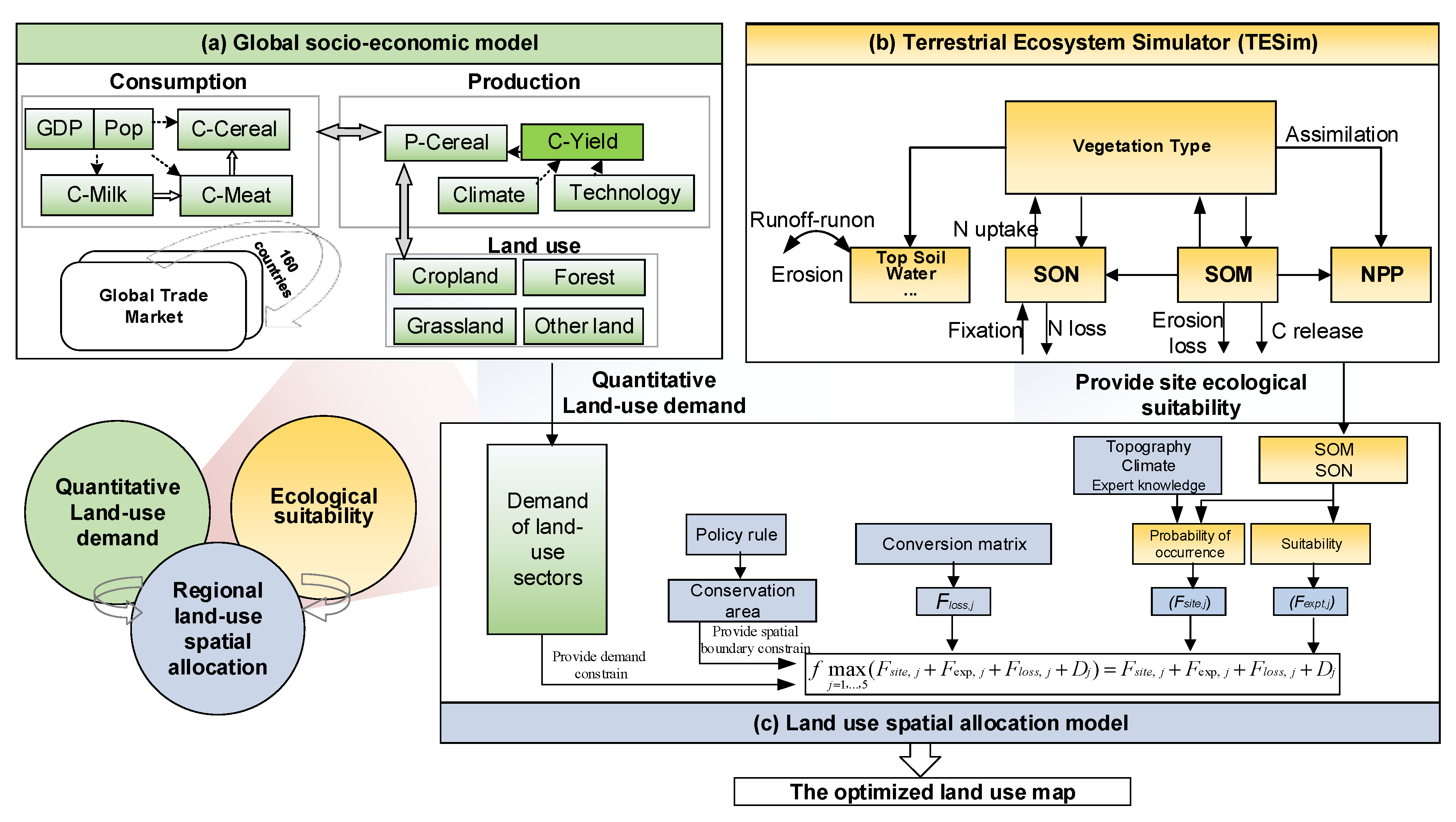
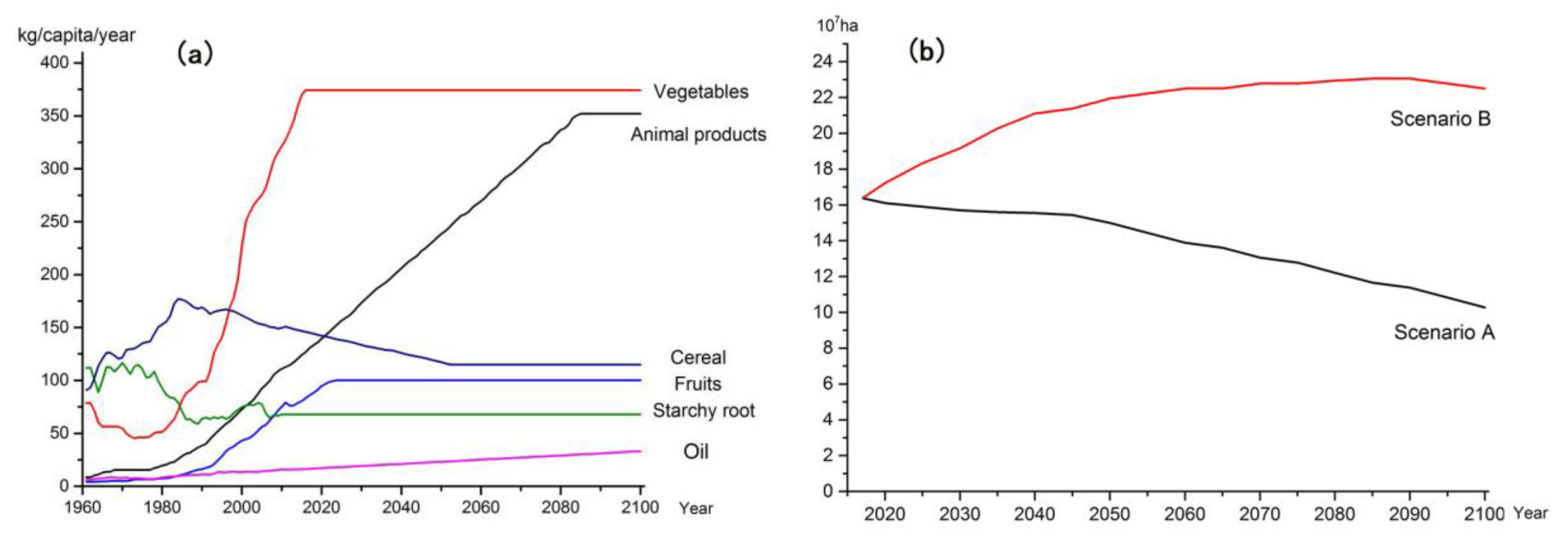

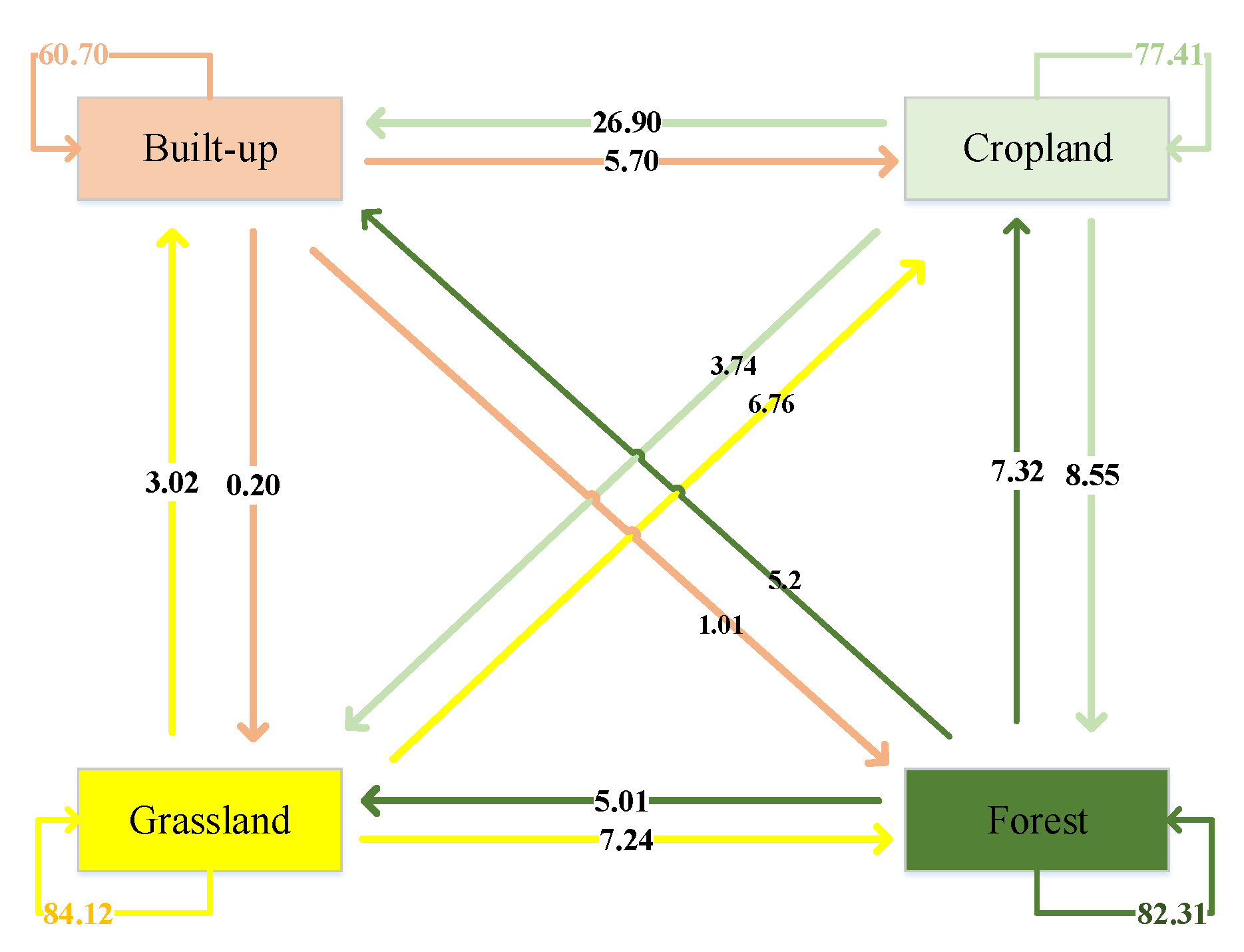
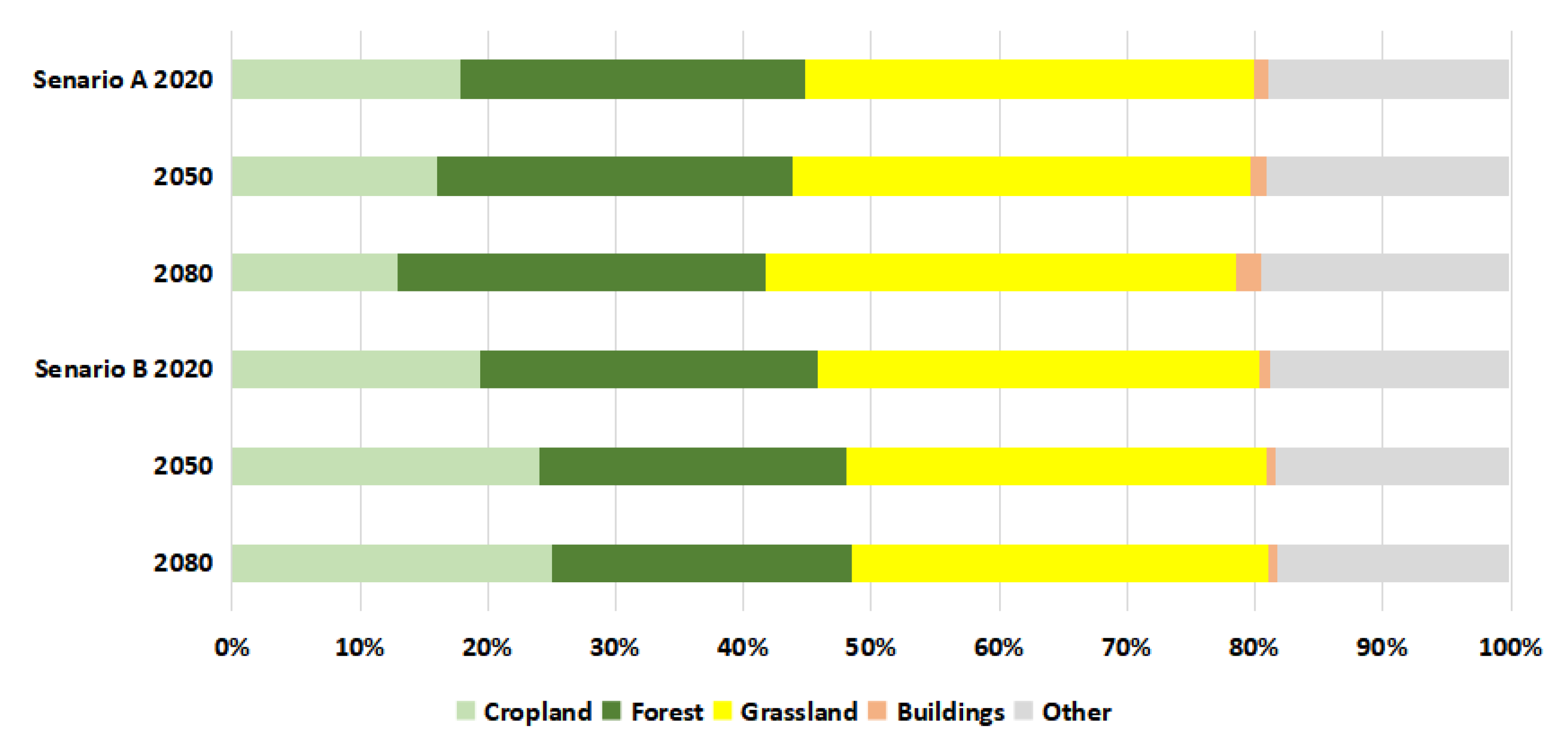
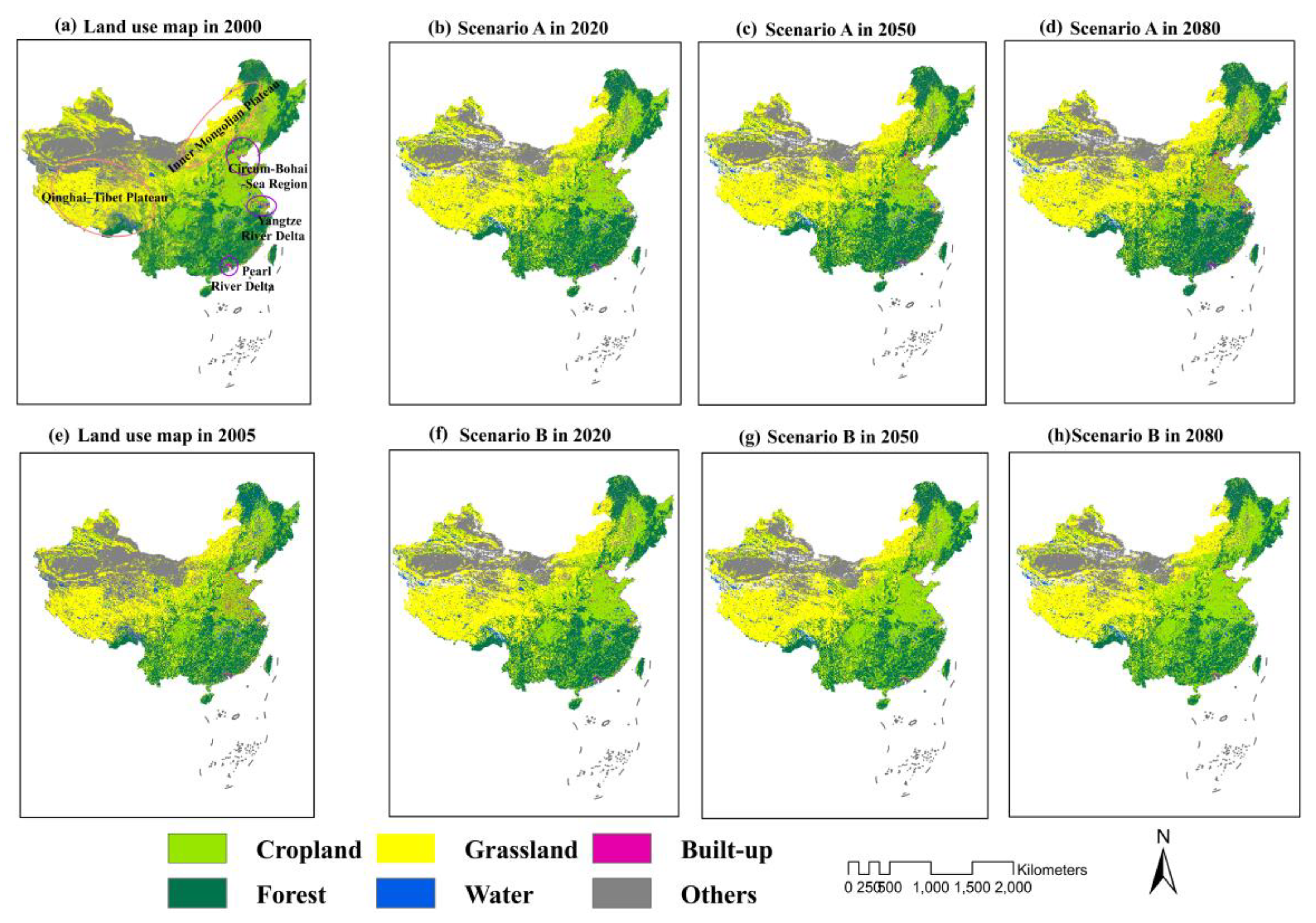
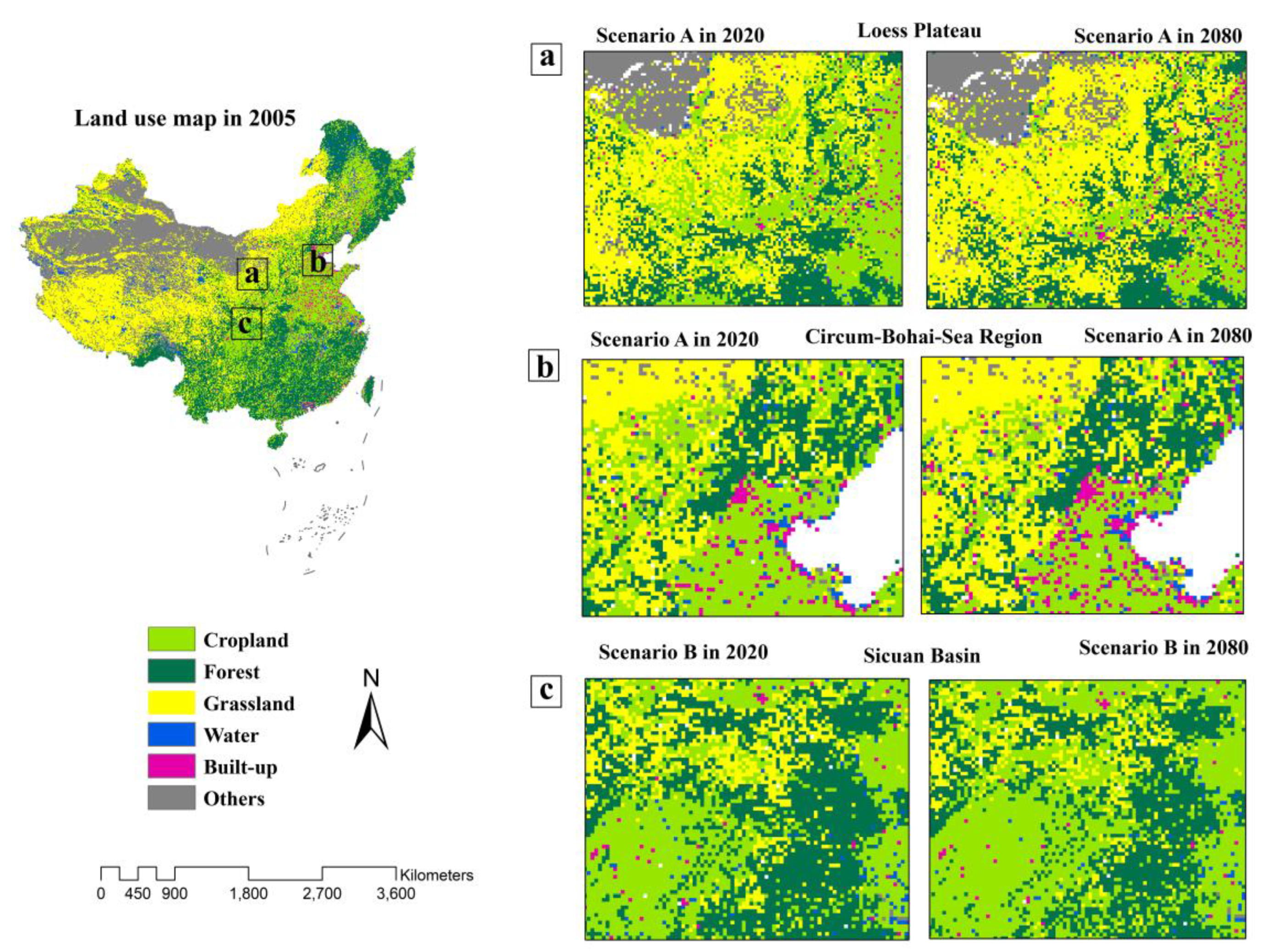

| Variables | Parameters | Description |
|---|---|---|
| Population | ※ [–1%, 1%] | At country level from Xu et al. [9] |
| GDP | ※ [–4%, 4%] | |
| Cereal consumption | ※ [–2%, 2%] | |
| Meat consumption | 0.5 [–10%, 10%] | Extension of the regression relationship between a country’s historic consumption per capita and its GDP per capita changes |
| Milk consumption | 0.3 [–10%, 10%] | |
| Land degradation or natural loss | –0.033 [–10%, 10%] | Soil is degraded mainly through deforestation and agricultural activities. We assigned 0.2% of the cropland and 0.5% of the natural forest as degraded into grassland and a grassland degradation rate of 0.3% (FAO, 2003; Jiang et al. [56]) |
| Trade (integrated market level) | 0.4 [–50%, 50%] | This determines the rate of trade to meet demand |
| Yield changes due to technology advancement | Scenario A: 0.02 [–10%, 10%] Scenario B: 0 | The yield in Scenario A will keep increasing; The yield in Scenario B will keep increasing at the same rate as in Scenario A until the yield reaches the current level. |
| Cropland | Forest | Grassland | Water Areas | Built-up | Other | |
|---|---|---|---|---|---|---|
| Conversion rate | 34.96 | 41.36 | 23.46 | 22.28 | 52.66 | 38.82 |
© 2019 by the authors. Licensee MDPI, Basel, Switzerland. This article is an open access article distributed under the terms and conditions of the Creative Commons Attribution (CC BY) license (http://creativecommons.org/licenses/by/4.0/).
Share and Cite
Jiang, H.; Xu, X.; Guan, M.; Wang, L.; Huang, Y.; Liu, Y. Simulation of Spatiotemporal Land Use Changes for Integrated Model of Socioeconomic and Ecological Processes in China. Sustainability 2019, 11, 3627. https://doi.org/10.3390/su11133627
Jiang H, Xu X, Guan M, Wang L, Huang Y, Liu Y. Simulation of Spatiotemporal Land Use Changes for Integrated Model of Socioeconomic and Ecological Processes in China. Sustainability. 2019; 11(13):3627. https://doi.org/10.3390/su11133627
Chicago/Turabian StyleJiang, Honglei, Xia Xu, Mengxi Guan, Lingfei Wang, Yongmei Huang, and Yinghui Liu. 2019. "Simulation of Spatiotemporal Land Use Changes for Integrated Model of Socioeconomic and Ecological Processes in China" Sustainability 11, no. 13: 3627. https://doi.org/10.3390/su11133627
APA StyleJiang, H., Xu, X., Guan, M., Wang, L., Huang, Y., & Liu, Y. (2019). Simulation of Spatiotemporal Land Use Changes for Integrated Model of Socioeconomic and Ecological Processes in China. Sustainability, 11(13), 3627. https://doi.org/10.3390/su11133627





